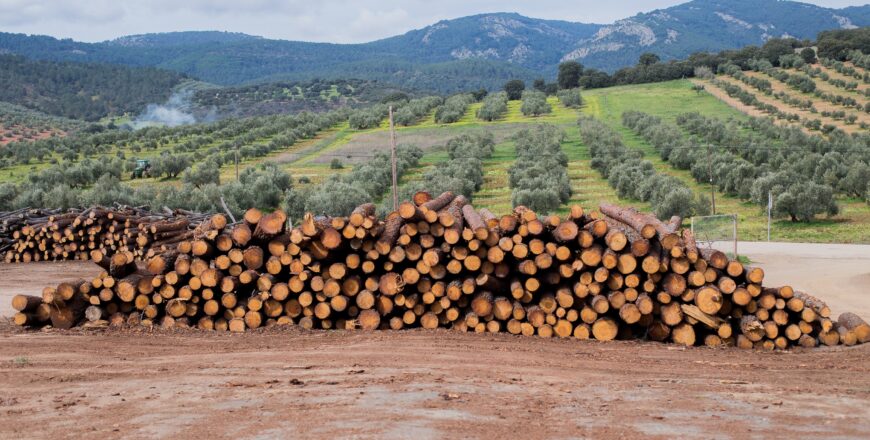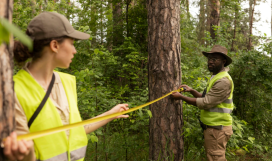Forestry: Timber Harvesting NQF Level 3

National Certificate: Forestry: Timber Harvesting NQF Level 3
PURPOSE AND RATIONALE OF THE QUALIFICATION
This qualification is aimed at people who work or intend to work within a timber harvesting context, and who seek recognition for essential skills in forestry operations.
Recipients of this qualification are able to enhance safety and productivity in timber harvesting, and this qualification provides evidence of a proven ability to:
- Use complex and sophisticated felling and extraction systems and machinery necessitating various specialised skills and operations
- Prepare an operational timber harvest plan;
- Manage oneself;
- Supervise other persons directly involved in the timber harvesting operation;
- Perform a range of work associated with timber harvesting;
- Solve problems that will be encountered in normal operating conditions
This qualification is designed to be flexible and accessible so that people are able to demonstrate the competencies required to work safely in timber harvesting in general and effectively and safely in at least one of the following mechanised timber harvesting specialist areas:
- Cable Yarding
- Feller Buncher
- Harvester
- Tractor
- Skidder
- Forwarder
Rationale of the qualification:
Candidates for this qualification are likely to be working in the forestry sub-field. The qualification will give them the opportunity to balance their practical skills with the essential knowledge required to earn a formal qualification in timber harvesting.
There is also a critical need in the industry to identify people who are able to conduct the essential operations associated with efficient and safe operation in at least one of the mechanised timber harvesting operations.
LEARNING ASSUMED TO BE IN PLACE AND RECOGNITION OF PRIOR LEARNING
It is assumed that candidates embarking on learning programmes towards this qualification may or may not have previous experience in the forestry industry and is therefore open to all learners.
Entry assumptions as stipulated in the individual unit standards will be applicable.
Recognition of prior learning
This qualification may be obtained through a process of RPL. The learner should be thoroughly briefed prior to the assessment and support provided to assist in the process of developing a portfolio. While this is primarily a workplace-based qualification, evidence from other areas of endeavour may be introduced if pertinent to any of the exit-level outcomes.
RECOGNISE PREVIOUS LEARNING?
Y
QUALIFICATION RULES
All Fundamental unit standards are compulsory (42 Credits).
All Core unit standards are compulsory (25 Credits).
A selection of one of the specialist areas:
Cable Yarding (51 Credits):
- Demonstrate knowledge of wire ropes, rigging accessories, anchor systems and rigging in cable yarding operations.
- Prepare anchors, rig intermediate supports, tailtrees and a tower and set up working cables for a cable yarding operation.
- Extract timber to a landing using a cable yarder in a production situation
- Load, off-load and stack timber using a loader in a production situation
- Choke and dechoke timber during extraction with a cable yarder in a production situation
Feller Buncher (53 Credits):
- Prepare, operate and maintain a mechanised harvesting machine
- Fell and bunch trees using a slew boom feller buncher in a non-production situation
- Fell and bunch trees using a feller buncher in a production situation
- Choke and dechoke timber during extraction with a skidding machine fitted with a winch
- Fell and bunch trees using a drive-to-tree feller buncher in a non-production situation
Harvester (97 Credits):
- Prepare, operate and maintain a mechanised harvesting machine
- Fell, debranch and debark trees using a harvester in a non-production situation
- Fell, debranch and debark trees using a harvester in a production situation
- Fell and process trees into products using a harvester in a non-production situation
- Fell and process trees into products using a harvester in a production situation
Tractor (55 Credits):
- Prepare, operate and maintain a tractor in a non-production situation
- Extract timber to a landing using a tractor fitted with a skidding attachment in a production situation
- Choke and dechoke timber during extraction with a skidding machine fitted with a winch
- Extract and short-haul timber using a tractor and trailer in a production situation
- Extract and short-haul timber using a tractor and trailer fitted with a self-loading crane in a production situation
Skidder (50 Credits):
- Extract timber to a landing using a cable skidder in a production situation
- Choke and dechoke timber during extraction with a skidding machine fitted with a winch
- Extract timber to a landing using a grapple skidder in a production situation
- Operate a skidding machine fitted with a winch in machine assisted tree felling
Forwarder (55 Credits):
- Extract logs to a landing using a forwarder in a production situation
- Load, off-load and stack timber using a loader in a production situation
A selection of a minimum of 5 credits from the following individual Elective unit standards:
- Fell trees with a chainsaw using the standard technique and felling Levers
- Delimb tree lengths using a static delimber in a production situation
- Fell trees using a chainsaw and machine assistance.
- Prepare, operate and maintain a 3-wheeled loader in a non-production situation
- Prepare, operate and maintain a self-propelled knuckle boom loader in a non-production situation
- Prepare, operate and maintain a vehicle mounted knuckle boom loader in a non-production situation
- Fell trees with a chainsaw using specialised techniques
- Scale tree lengths into poles in a production situation
- Scale tree lengths into saw and veneer logs in a production situation
- The total minimum combination of credits for this qualification is 122.
EXIT LEVEL OUTCOMES
- Demonstrate the ability and understanding to communicate in a variety of ways and use mathematics in real life situations which are suitable to and in the context of this qualification.
- Demonstrate the ability to maintain safe work operations in a forestry environment.
- Demonstrate the ability to plan a timber harvest operation.
- Demonstrate the ability to use a chainsaw safely in a production environment.
- Demonstrate knowledge of timber harvesting operations in relation to the forestry environment.
- Demonstrate the ability to extract timber using cable yarding systems in a production situation.
- Demonstrate the ability to fell timber with a feller buncher in a production situation.
- Demonstrate the ability to fell and prepare timber with a harvester in a production situation.
- Demonstrate the ability to extract timber with a tractor in a production situation.
- Demonstrate the ability to extract timber with a skidder in a production situation.
- Demonstrate the ability to extract timber with a forwarder in a production situation.
- Demonstrate an understanding of options for further learning in this or a related field of learning and preparation requirements for such learning.
ASSOCIATED ASSESSMENT CRITERIA
1.
- Communication is regular and ongoing.
- Information is clear and accurate and conveyed in a timely manner.
- Relationships with peers and supervisory/management levels are established and functioning.
2.
- Safety procedures during wildfire suppression are identified and explained
- An understanding of how to contribute to suppression of wild fires is demonstrated
- Knowledge of basic safety in forestry operations is demonstrated
3.
- The ability to conduct basic forestry map reading is demonstrated
- The ability to prepare an operational timber harvest plan is demonstrated
4.
- The ability to use and maintain a chainsaw is demonstrated
- Trees are felled using standard techniques and felling levers
- Felled trees are de-branched and cross-cut in a production situation
- Learner is able to evaluate the benefits and difficulties of team work within his/her own work context
- Safe working practices are explained and demonstrated
- Appropriate Legislation is referred to when explanations are given.
5.
- Knowledge of key elements of commercial forestry is demonstrated
- Knowledge of mechanical timber handling equipment is demonstrated
- Knowledge of cable extraction is demonstrated
- Knowledge of choking and de-choking timber is demonstrated
- Knowledge of ground-based machine extraction is demonstrated
- Learner is able to evaluate the benefits and difficulties of team work within his/her own work context
- Safe working practices are explained and demonstrated
- Appropriate Legislation is referred to when explanations are given.
- Knowledge of rigging equipment and accessories is demonstrated
- The ability to prepare rigging equipment and accessories is demonstrated
- The ability to use a cable yarder in a production situation is demonstrated
- The ability to use a loader in a production situation is demonstrated
- Learner is able to evaluate the benefits and difficulties of team work within his/her own work context
- Safe working practices are explained and demonstrated
- Appropriate Legislation is referred to when explanations are given.
- The ability to prepare, operate and maintain a mechanised timber harvesting machine is demonstrated
- The ability to use a feller buncher in a non-production and production situation is demonstrated
- The ability to choke and dechoke timber with a skidding machine is demonstrated
- Learner is able to evaluate the benefits and difficulties of team work within his/her own work context
- Safe working practices are explained and demonstrated
- Appropriate Legislation is referred to when explanations are given.
- The ability to prepare, operate and maintain a mechanised timber harvesting machine is demonstrated
- The ability to fell, debranch and debark trees in a production and non-production situation is demonstrated
- The ability to fell and process trees in a production and non-production situation is demonstrated
- Learner is able to evaluate the benefits and difficulties of team work within his/her own work context
- Safe working practices are explained and demonstrated
- Appropriate Legislation is referred to when explanations are given.
- The ability to prepare, operate and maintain a tractor in a non- production situation is demonstrated
- The ability to extract timber with an attachment is demonstrated
- The ability to choke and dechoke timber with an attachment is demonstrated
- The ability to extract and transport timber with an attachment is demonstrated
- The ability to extract and transport timber with an attachment fitted with a self loading crane is demonstrated
- Learner is able to evaluate the benefits and difficulties of team work within his/her own work context
- Safe working practices are explained and demonstrated
- Appropriate Legislation is referred to when explanations are given.
- The ability to extract timber to a landing is demonstrated
- The ability to choke and dechoke timber fitted with a winch is demonstrated
- The ability to operate a skidding machine in machine assisted tree felling is demonstrated
- Learner is able to evaluate the benefits and difficulties of team work within his/her own work context
- Safe working practices are explained and demonstrated
- Appropriate Legislation is referred to when explanations are given.
- The ability to extract logs in a production situation is demonstrated
- The ability to load, off-load and stack timber in a production situation is demonstrated
- Learner is able to evaluate the benefits and difficulties of team work within his/her own work context
- Safe working practices are explained and demonstrated
- Appropriate Legislation is referred to when explanations are given.
- The various options for further learning and the purpose thereof are explained.
- The preparation requirements are explained and the learning areas identified and selected.
- An individual learning plan is developed in the context of the qualification and the workplace.
Integrated Assessment
Integrated assessment at the level of the qualification provides an opportunity for learners to show they are able to integrate concepts, actions and ideas achieved across a range of unit standards and contexts. Integrated assessment must evaluate the quality of observable performance as well as the thinking behind the performance.
Some assessment aspects will demand practical demonstration while others may not. In some case inference will be necessary to determine competence depending on the nature and context within which performance takes place.
Since this is a foundational qualification, it is necessary to ensure that the fundamental part of the qualification is also targeted to ensure that while the competence may have been achieved in a particular context, learners are able to apply it in a range of other contexts and for further learning. The assessment should also ensure that all the critical cross-field outcomes have been achieved.
INTERNATIONAL COMPARABILITY
This qualification and the component unit standards have been compared with similar qualifications from New Zealand. The New Zealand Qualifications Framework has two qualifications that relate to this one: National Certificate in Forestry (Timber harvesting) at level 4, consisting of 230 credits and the National Certificate in Forestry (Mechanised timber harvesting) also at level 4, consisting of 230 credits.
It was felt that 2 different qualifications would not serve the purpose for South African conditions, therefore a direct comparison between the New Zealand and the South African qualification cannot be made, although there are similarities in some of the unit standards that are included.
ARTICULATION OPTIONS
- The qualification has been designed and structured so that qualifying learners can move from one context to another.
- Employers or institutions should be able to evaluate the outcomes of this qualification against the needs of their context and structure top-up learning appropriately.
- Equally, holders of other qualifications may be evaluated against this qualification for the purpose of RPL.
MODERATION OPTIONS
- Anyone assessing a learner against this qualification must be registered as an assessor with the relevant ETQA.
- Any institution or learning provider offering learning towards the achievement of this qualification should be accredited as a provider with the relevant ETQA.
- Moderation of assessment should be overseen by the relevant ETQA according to the moderation guidelines provided for in this qualification as well as the agreed ETQA procedures.
CRITERIA FOR THE REGISTRATION OF ASSESSORS
The following criteria should be applied by the relevant ETQA:
- Appropriate qualification and a minimum of 3 years experience in the field of Forestry: Timber Harvesting or a similar environment. The subject matter experience of the assessor can be established by recognition of prior learning.
- Appropriate experience and understanding of assessment theory, processes and practices
- Good interpersonal skills and the ability to balance the conflicting requirements of:
- Maintaining national standards
- The interests of the learner
- The need for transformation and redressing the legacies of the past
- The cultural background and language of the learner
- Registration as an assessor with the relevant ETQA
REREGISTRATION HISTORY
As per the SAQA Board decision/s at that time, this qualification was Reregistered in 2012; 2015.






